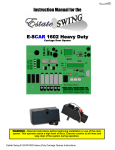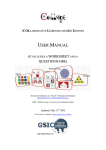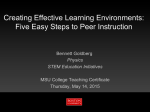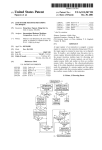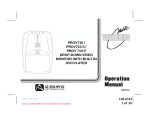Download Interactive Simulations for Teaching and Learning Physics
Transcript
PhET: Interactive Simulations for Teaching and Learning Physics Katherine Perkins, Wendy Adams, Michael Dubson, Noah Finkelstein, Sam Reid, and Carl Wieman University of Colorado at Boulder Ron LeMaster Kavli Operating Institute The Physics Education Technology (PhET) project is an ongoing effort to provide an extensive suite of simulations for teaching and learning physics and to make these resources both freely available from the PhET website (phet.colorado.edu) and easy to incorporate into classrooms. The simulations (sims) are animated, interactive, and game-like environments in which students learn through exploration. In these sims, we emphasize the connections between real life phenomena and the underlying science and seek to make the visual and conceptual models of expert physicists accessible to students. We use a research-based approach in our design – incorporating findings from prior research and our own testing – to create sims that support student engagement with and understanding of physics concepts. We currently have about 35 sims posted on our website. Most of these sims cover introductory high school and college physics, but some focus on making traditionally more-advanced topics (e.g. lasers, semiconductors, greenhouse effect, radioactivity and nuclear weapons) accessible to students. On the website, the sims are organized under seven somewhat loose and partially overlapping categories: Motion; Work, Energy & Power; Sound & Waves; Heat & Thermo; Electricity & Circuits; Light & Radiation; Quantum Phenomena; and Math Tools. We update the website regularly with newly developed or improved sims, and we plan to post 10-20 new sims by the end of 2005. In this article, we introduce the PhET sims and their basic design; we describe how to access and run the sims; and we provide suggestions for effectively incorporating the sims into a variety of educational settings. Creating PhET Sims for Engagement and Learning We have two main goals for the PhET sims: increased student engagement in learning and improved learning. Our target users are today’s physics students – a widely diverse population of young people. Thus, much of our attention focuses on connecting with the student and on creating student-sim interactions that facilitate construction of a robust conceptual understanding of the physics. While we do draw from the research literature on how students learn1, conceptual difficulties in physics2, and educational technology design3, we also make extensive use of student interviews and classroom testing to uncover any usability, interpretation, or learning issues and to develop a set of principles for highly effective designs. We design the sims to present an appealing environment that literally invites the student to interact and explore in an open-style play area with simple, intuitive controls, e.g. click-and-drag manipulation, sliders, and radio buttons. In the Ideal Gas sim (Fig. 1), for example, the opening panel greets the user with a wiggling invitation to “Pump the handle!”. We use many connections to everyday life, both to engage the students and to support their learning by providing ties to their own experiences. This emphasis influences both the small details (e.g. using a bicycle pump to add gases) and the larger design questions where the underlying science is often presented in the context of real life phenomena (e.g. learning about buoyancy with hot air and helium balloons in Ideal Gas). Submitted to The Physics Teacher (Nov. 2004) 1 Figure 1. In the Ideal Gas sim, pump the handle to add heavy or light particles to the box and see them move about, colliding with each other and the walls. Cool the box with “ice” and see the particles motion slow as the thermometer and pressure gauge readings fall. Increase gravity and see a pressure gradient form. Using dynamic graphics, the PhET sims explicitly animate the visual and conceptual models that expert physicists use in their understanding. In many cases, the sims show what’s not ordinarily visible to the eye, e.g. atoms, electrons, photons, and electric fields. All of the PhET sims directly couple the student’s interaction with the animation. Adjustment of any controls results in an immediate animated response in the visual representations, making these sims particularly good for establishing cause-and-effect relationships and for enhancing students’ abilities to connect multiple representations. For more quantitative explorations, the sims have various measurement instruments available, e.g ruler, stop watch, voltmeter, thermometer, pressure gauge, etc. The Ideal Gas sim described in Fig. 1 illustrates many of these design features. Making PhET Sims Accessible These sims are easy to access and free at the PhET website (phet.colorado.edu). We write the sims in either Java or Flash so that they can be run using a standard web-browser with the recent Flash and Java virtual machine plug-ins. We provide instructions on how to download these free plug-ins for users who do not have them. In addition to being able to run the sims directly from the website, users can download an installer file (currently about 45 MB) which will install the entire website on to any local machine for use offline. This is particularly convenient if either the student computer lab or the lecture halls do not have an internet connection available. We recommend using these sims on PCs. The Flash-based sims work well on Macs, but the Java-based sims will only work on Macs running OSX – the older the version of OSX, the less reliable the Apple Java code. Even with the latest software, the Java-based sims often still run slower on Macs than on PCs. Teaching and Learning with PhET Sims Each PhET sim is created as a stand-alone, open learning tool often with several layers of complexity, giving teachers the freedom to pick and choose which sims to use and how to incorporate these into their class. While our design approach emphasizes improved conceptual understanding, the sims are most effective when students’ use is constrained to be productive, either through instructor guidance in lecture or through the use of a guided activity in homework, lab, or recitation. Here, we want to introduce some of the PhET sims and provide some suggestions for how to effectively incorporate these sims into different learning environments. Many of the examples come from our large lecture course – “The Physics of Everyday Life” – for non-science majors (though we have also used these sims effectively in algebra- and calculus-based introductory courses and advanced level courses such as physical chemistry). Submitted to The Physics Teacher (Nov. 2004) 2 A Violin string and harmonics: A B C snapshots at different times. B When the string is in position B, instantaneously flat, the velocity of points of the string is... % Correct : A: zero everywhere. B: positive everywhere. 2002 demo: 27% C: negative everywhere. D: depends on the position. 2003 sim: 71% Figure 3. In the Sweater-Balloon sim, students can rub the balloon on the sweater and then stick it to the wall while seeing the charges move and the effects of Coulomb attraction. Lecture. These sims are versatile tools for teaching in lecture: serving as powerful visual aids; complementing traditional classroom demos; and providing opportunities for interactive engagement Figure 2. In Wave-on-a-String sim, you can wiggle the through sim-based interactive lecture demos4 or end of the string with the mouse or a piston to create a concept tests. wave and explore effects of tension and damping. Here we use the sim (A) to helps students visualize a standing Every physics teacher knows that it is often wave and follow with concept tests (B). Even after very difficult for students to visualize the physics. discussing the first concept test, only 23% of the students We use pictures, words and gestures in an attempt shown the tygon tube demo answered correctly compared to help them share the same visual models that have with 84% of the students shown the sim. worked for us. Unfortunately, this is not always successful – a student’s picture may not be the same or necessarily useful. When using the sims, the students and the teacher see the same objects and motions, allowing the teacher and students to focus their time and attention on creating an understanding of the physics rather than on establishing a common picture. In teaching about the physics of violins, we wanted students to have a good visualization of a standing wave on a string. In 2002, we used the conventional demonstration of shaking a long tygon tube stretched across our lecture hall to create a standing wave. In 2003, we demonstrated the motion of a standing wave with our Wave-on-a-String sim shown in Fig. 2A. We followed each demo with the two concept tests in Fig. 2B. As shown, the sim was much more effective at helping the students visualize the string’s motion. We regularly use the sims to show students what is not visible to the eye. When teaching about electrostatics for instance, we follow the traditional balloon demos with the Sweater-Balloon sim in Fig. 3 where the students can now see the electric charges. This sim is relatively simple but effective, animating the Coulomb attraction between oppositely charged objects and the movement of negative charges (electrons) as they are transferred from the sweater to the balloon when rubbed together. Polarization is also represented as the negative charges in the wall shift away from their positive ion cores (nuclei) as a charged balloon approaches. Follow up question: At position C, the velocity of points of the string is... % Correct : B: positive everywhere. A: zero everywhere. 2002 demo: 23 % C: negative everywhere. D: depends on the position. 2003 sim: 84% Submitted to The Physics Teacher (Nov. 2004) 3 Figure 4. In Radio Waves, users create EM waves by moving the electron in the broadcasting antenna either by hand (mouse) or by setting the frequency and amplitude of oscillation. Here we’ve created a concept test to help students distinguish between wave speed and frequency. Figure 5. In Moving Man, users control the man’s motion either by dragging the man about or using the position, velocity, or acceleration controls. By graphing the motion simultaneously and including a “playback” feature, this sim helps students build connections between actual motions and their graphical representation. These sims naturally couple with the use of interactive engagement techniques in the classroom. In our classrooms, we use an adaptation of Mazur’s Peer Instruction5 technique with both concept tests and interactive lecture demos. In teaching about electromagnetic waves, students are challenged to understand and conceptualize: how EM waves are created by accelerating charges, how they exert forces on charges, and how their frequency, wavelength, and wave speed are related. We use the Radio Waves sim in guiding students’ understanding of these ideas. In the PowerPoint slide in Fig. 4, we ask the students to discuss and vote on how the speed of the wave is measured. About 1/3 of our students had not yet clearly distinguished the ideas of frequency and speed. By using the sim, we were able to immediately address this confusion; we focused the students’ attention on following the peak as it moved to the right and relating that to the speed of the wave. By varying the frequency, we showed students that speed is independent of frequency. The sims are also useful tools for interactive lecture demos (ILDs). For instance, the Moving Man sim (Fig. 5) is ideal for use with Thornton and Sokoloff’s force and motion ILD where students predict the graphs of position, velocity, and acceleration for a described motion.4 Using the Moving Man sim, the student’s predictions are tested as the instructor reproduces the described motion of the man on the sidewalk and graphs of position, velocity, and acceleration simultaneously appear. This motion can be repeated with the sim’s “playback” feature or the position scale on the sidewalk can be flipped with “invert x-axis” to guide students’ thinking about the meaning of the sign of velocity and acceleration. We have noticed that using sims in lecture often leads to unprompted high quality questions and comments from students e.g. connecting to their own experiences, asking probing “what if” questions, or extending the discussion to applications or consequences of the physics. With the open design of the sims, we are often able to immediately use the sim to test the students’ ideas or answer their questions. Submitted to The Physics Teacher (Nov. 2004) 4 Figure 6. The Masses and Springs sim creates an open lablike environment in which students are free to investigate. Challenge them to measure the mass of the green weight, to measure gravity on Planet X, or to make sense of the energy conversions. Figure 7. In the CCK sim, students can construct these circuits, close the switch, and immediately see the response – the electrons flow faster from the battery, the ammeter reads higher, the voltage meter reads lower, and one bulb dims while the other bulb glows brighter. Results from a recent study show improved performance on the final from students using CCK in lab. Lab/Recitation. These sims are specifically designed to allow students to construct their own conceptual understanding of physics through exploration. This makes them useful learning tools for small group activities in lab and recitation. We have found that such activities need to have well-defined learning goals and be designed to guide, but not excessively constrain, the students’ exploration of the sim – promoting lines of inquiry that help students develop their understanding of the important concepts. A number of the PhET sims are particularly well-suited for use in these environments, including Moving Man, Circuit Construction Kit, Masses and Springs, and Ideal Gas. In Masses and Springs (Fig. 6), students can complete traditional laboratory activities, such as hanging objects on springs and measuring spring displacement or oscillation period; however, students can extend their exploration by slowing down time and following the conversion between different forms of energy, by instantaneously porting the whole apparatus to a different planet, or by varying the spring constant continuously. With the lifelike look and feel of the sim, the students’ interactions mimic the real world experience in many ways. Through guided activities that investigate the physics of spring scales or bungee jumpers for example, students can reason about and construct a conceptual understanding of a range of topics including Hooke’s law, damped and undamped harmonic oscillators, conservation of energy, and net force and motion. In several ways the Circuit Construction Kit (CCK) sim (Fig. 7) offers a learning environment similar to a real-life lab. Students connect light bulbs, switches, batteries, resistors, and wires to create arbitrarily complex DC circuits. Realistic looking voltmeters and ammeters are used to measure voltage differences and currents. But to this, the CCK adds an animation of the electrons flowing through the circuit elements and the ability to continuously adjust the resistance of any component (including the light bulbs) or the voltage of the battery. For example, after building the circuit in Fig 3, students can close the switch and continuously change the resistance of the 10 ohm resistor. Simultaneously the students observe the effect on the motion of electrons, the brightness of the bulbs, and the measured voltage difference. These features provide the students with powerful tools in understanding current and investigating the cause-and-effect relationships between voltage, current, resistance, and power. Submitted to The Physics Teacher (Nov. 2004) 5 In a recent research study, we found that the students who used CCK in lab performed better on conceptual questions about circuits than the students who used real equipment (Fig. 7 inlay).6 While it is reasonable to suspect that the CCK students would have more difficulty building a circuit out of real equipment, the same study demonstrates that the CCK students could actually construct real circuits as well as or better than the students who had used the real equipment in an identical lab experience.6 While it is useful for students to make sense of the non-idealized, real-world situation, these sims use a layered structure to allow students to first explore and construct a conceptual understanding with idealized equipment and then to extend beyond this ideal to make sense of more Figure 8. In the Sound sim, a speaker oscillates back and subtle complexities encountered in real life. For forth producing pressure waves that propagate from the speaker. Students can: adjust frequency and amplitude; see example, in CCK, the advanced features introduce finite resistivity to the wires and an internal changes in the pressure waves and hear changes in pitch and volume; use the ruler and timer on the “Measure” resistance to the batteries. panel to measure speed, frequency, period, and wavelength; and look at and listen to the interference of waves from two speakers on the “Interference” panel. Homework. As with lab or recitation activities, we design homework questions that guide the students’ work with the sim. These questions require the student to interact with the sim to discover, explain, or reason about the important physics concepts. Often we ask the students to explore cause-and-effect relationships, both qualitatively and quantitatively, or make connections to their everyday life experiences. We use a range of question styles – true/false, multiple choice, numeric, and essay response. We prefer essay-style questions where students must explain their ideas and reasoning in words, but we are limited by grading time in our large-enrollment courses. In homework on sound, we ask students to make sense of what the Sound sim (Fig. 8A) is showing with true/false (Fig. 8B) and essay questions: “You hear a Concert A tone from the speaker. Describe the required motion of the speaker and how this motion leads to detection of Concert A by your ear. Include in your explanation the chain of cause-and-effect logic.” In a discovery exercise, students are asked to use the ruler and timer in the “Measure” panel to develop a procedure for measuring the speed of sound and then measure the speed at 200 Hz and at 400 Hz. We ask them: “Does the speed depend on the frequency? How are your observations consistent or inconsistent with your experience in everyday life? Explain.” They also measure the period and wavelength at these frequencies and explain how this is consistent or inconsistent with their measurement for the speed. Hearing from the students At the end of the term, we asked the students in our large lecture how useful the sims were for their learning in the course, responding on a 5-point scale from “not useful” to “a great deal”. For the usefulness of sims in lecture, 62% of the students rated the sims as very useful for their learning (4-5) with an additional 22% finding them somewhat useful (3). When asked about the usefulness of the homework questions coupled with sims, 49% rated these as very useful with an additional 24% finding Submitted to The Physics Teacher (Nov. 2004) 6 them somewhat useful. In contrast, only 27% found their text very useful with the majority (52%) rating the text of little use in their learning (1-2). When we receive complaints from the students about the sims, they tend to fall into two categories – trouble getting the sims to run on their home computer (typically because they have a Mac or a slow internet connection) or the discovery of an unknown bug within the sim. The easiest solution to the first issue is to make sure the students have access to a school computer which is ready to run the sims. As for the second, students are our best testers, and we fix the bugs as they find them. In a calculus-based physics course, we recently used the CCK sim in conjunction with the Tutorials-in-Physics7 for the circuits tutorial. In a follow-up survey, we asked students to comment on which of the tutorials (out of the 9 they had completed so far) had been particularly effective. Of those who listed specific tutorial(s), about 70% identified the circuits tutorials in which they used CCK. This favorable response is similar to when real batteries and light bulbs are used in tutorial, but two strong themes emerged in the comments on the CCK sim – how helpful it was to be able to easily experiment and adjust the circuits and how the sim helped with visualizing what was going on: “I really like the circuits tutorial where i got to build circuits on the computer and change variables to see an instantaneous reaction. This really helped me conceptualize circuits, resistors, etc...” “I liked the Voltage, Current and Resistance tutorial with the computers. I am a visual learner, and I am strugging with electricity because it is not something you can really see. I mean you can see a light bulb go on, but you can not see what is going on inside. The tutorial with the computers helped me out, because they showed what was really going on inside the circuit.” Finally, we asked our students if they “missed” having sims on the topics (MRIs, x-rays, cameras) where they had not been used. Most said they would have used these sims to help their learning. PhET is an ongoing program. We continue to upgrade older sims and add new ones. By the end of 2005, we expect to have added enough new sims to cover nearly all of the core content in introductory college physics. During this time, we will also be expanding our coverage of quantum physics and physical chemistry and developing a shared electronic space for PhET sim educators. This space will provide the community of educators using PhET sims with a forum for sharing guided discovery activities, concept tests, or other curricular materials that they have written and tested with their students. We are pleased to acknowledge support for this work by the NSF, the Kavli Operating Institute, and the University of Colorado. We thank Steve Pollock, Chris Keller, and the other members of the newly formed Physics Education Research Group at Colorado (PER@C) for their valuable contributions to this effort. References 1. e.g. J.D. Bransford, A L. Brown, and R. R. Cocking, editors How People Learn (Natl. Acad. Press, Washington, DC, 2002). 2. e.g. references within L.C. McDermott and E.F. Redish, “Resource letter on Physics Education Research,” Am. J. Phys. 67, 755-772 (1999). 3. e.g. R.C. Clark and R.E. Mayer, e-Learning and the Science of Instruction: Proven Guidelines for Consumers and Designers of Multimedia Learning, (Pfeiffer, San Francisco, CA, 2003). 4. D. Sokoloff and R. Thornton, “Using interactive lecture demonstrations to create an active learning environment,” The Phys. Teach. 35, 340-346 (1997). 5. E. Mazur, Peer Instruction: A User’s Manual (Prentice-Hall, New Jersey, 1997). 6. N. Finkelstein, W. Adams, C. Keller, P. Kohl, K. Perkins, N. Podolefsky, S. Reid , and R. LeMaster, “When learning about the real world is better done virtually: a study of substituting computer simulations for laboratory equipment”, submitted to Phys. Rev. - PER, 2004. Submitted to The Physics Teacher (Nov. 2004) 7 7. L.C. McDermott, P.S. Shaffer, and the Physics Education Group at the University of Washington, Tutorials in Introductory Physics (Prentice-Hall, New Jersey, 2002). The PhET Team Members: Carl Wieman, Distinguished Professor of Physics and a Fellow of JILA, leads the PhET project housed in the Department of Physics at the University of Colorado at Boulder. Other departmental team members include: Katherine Perkins (research associate and lecturer), Wendy Adams (graduate student), Michael Dubson (senior instructor and flash programmer), Noah Finkelstein (assistant professor), Sam Reid (software engineer), and Krista Beck (administrative assistant). Ron LeMaster (software engineer) is supported by the Kavli Operating Institute. Contact: Katherine Perkins, Department of Physics, UCB 390, University of Colorado at Boulder, Boulder, CO 80309; [email protected] Submitted to The Physics Teacher (Nov. 2004) 8








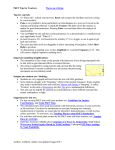

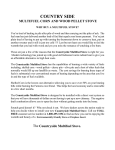
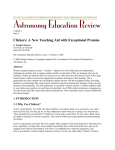

![User's Manual DP8340II SERIES [Parallel]](http://vs1.manualzilla.com/store/data/006876520_1-e14f27ca3e82bd4fbe61e6010073af1e-150x150.png)
